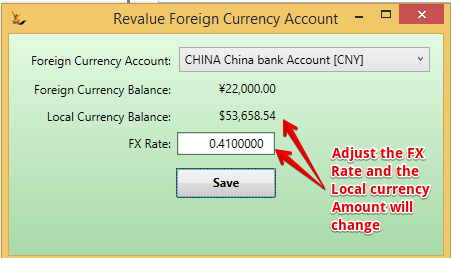...
- Any entity you deal with in a foreign currency - all transactions will be in that currency
- Your GL is always in local currency
- So transactions are always converted using the exchange rate to local currency
- Transactions will have their own exchange rate
- Reconciling transactions with different exchange rates (payment to invoice or credit note to invoice etc) will result in a realised gain or loss journal being created
- Bank accounts may have no transactions - however due to exchange rate movements you may need to revalue the local currency equivalent in the system
- Exchange rates can be maintained centrally and will default onto transactions - however they may be overwritten at the transaction level.
- Bank Reconciliation is in the foreign currency
- When creating Journals from the bank reconciliation screen > the FX value is fixed based on the value on the bank statement upload
- Changes
- If the FX Rate is changed:
- If the journal has a bank account and has been cleared in a bank rec then the amount of the bank account currency will be preserved and the other currency amount will be recalculated using the changed FX Rate.
- Otherwise the user will be asked if the local or foreign currency amount should be recalculated.
- If the local currency amount is changed:
- If the journal has a foreign currency bank account and has been cleared in a bank rec then the FX Rate will be recalculated.
- Otherwise the user will be asked if the foreign currency amount or the FX Rate should be recalculated.
- If the foreign currency amount is changed:
- If the journal has a local currency bank account and has been cleared in a bank rec then the FX Rate will be recalculated.
- Otherwise the user will be asked if the local currency amount or the FX Rate should be recalculated.
- Allocations are removed and a message displayed when
- Allocations exist
- The client is changed (Debtor or Creditor)
- Local currency amount of a local currency journal is reduced
- The FX currency amount of a FX currency journal is reduced
- If the FX Rate is changed:
- Marketplace Orders
- Definition: Drop Ship on behalf of a customer direct to their customer - ie Amazon, Myer Drop Ship, Catch of the Day etc.
- Are invoiced in bulk - so many orders are on a single invoice.
- Therefore the FX rate on the order is not relevant - the FX rate on the invoice is and the order must be updated
- When an invoice is created for marketplace orders then, for each order:
- If the FX rate of the order is different to the FX rate of the invoice then:
- Change the FX rate of the order to match the invoice.
- Recalculate the GP% of the order and the line margins and save them.
- If the FX rate of the order is different to the FX rate of the invoice then:
- If the FX rate of a debtor invoice is changed and saved and there are marketplace order lines linked to the invoice lines then, for each order:
- If the FX rate of the order is different to the FX rate of the invoice then:
- Change the FX rate of the order to match the invoice.
- Recalculate the GP% of the order and the line margins and save them.
- If the FX rate of the order is different to the FX rate of the invoice then:
Selling or Purchasing in a foreign currency
...
Normally this in only done at the end of a reporting period - but it can be done anytime
Can access from the Action menu on the bank account
A general journal will be created between the FX bank account and the account you have setup in GL Control Accounts for Foreign Currency Gains / Losses (normally an operating expenses account)
...

